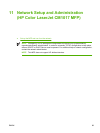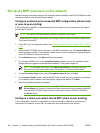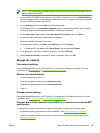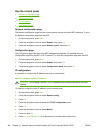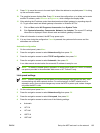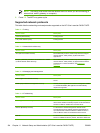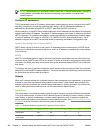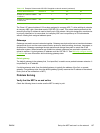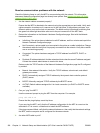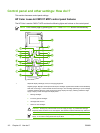
Service name Description
MFP to generate a unique IP address. For example, the IP
address 169.254.0.10 represents a series of triplets ranging
from 0 to 254; this address is not manually configurable.
TCP/IP
TCP/IP (Transmission Control Protocol/Internet Protocol) is a suite of protocols designed to define the
way computers and other devices communicate with each other over a network.
TCP/IP is rapidly becoming the most used set of protocols because the Internet is based on TCP/IP. If
there is a network that you want to connect to the Internet, use TCP/IP to communicate.
NOTE This MFP does not support IP V6.
Internet Protocol (IP)
When information is sent across the network, the data is broken down into small packets. Each packet
is sent independently of one another. Each packet is encoded with IP information, such as the IP address
of the sender and receiver. IP packets can be routed over routers and gateways, devices that connect
a network with other networks.
IP communications is connectionless. When IP packets are sent, there is no guarantee that they arrive
at their destination in the proper sequence. That task can be performed by higher level protocols and
applications thereby allowing IP communications to be efficient.
Each node or device that communicates directly onto the network requires an IP address.
Transmission Control Protocol (TCP)
TCP handles breaking the data into packets and recombining the packets on the receiving end by
providing a connection-oriented, reliable, and guaranteed delivery service to another node on the
network. When data packets are received at their destination, TCP calculates a checksum for each
packet to verify the data is not corrupt. If the data in the packet has been corrupted during transmission,
TCP discards the packet and requests that the packet be resent.
User Datagram Protocol (UDP)
UDP provides similar services to TCP. However, UDP does not acknowledge data receipt and supports
request/reply transactions with no added reliability or guarantee of delivery. UDP is used when
acknowledgment and reliability are not required, such as during a “discovery broadcast.”
IP address
Every host (workstation or node) on an IP network requires a unique IP address for each network
interface. This address is a software address that is used to identify both the network and specific hosts
located on that network. Each IP address can be divided into two separate parts: the network portion
and the host portion. It is possible for a host to query a server for a dynamic IP address each time the
device boots up (for example, using DHCP and BOOTP).
Table 11-4 IP addressing (continued)
ENWW Set up the MFP and use it on the network 105





